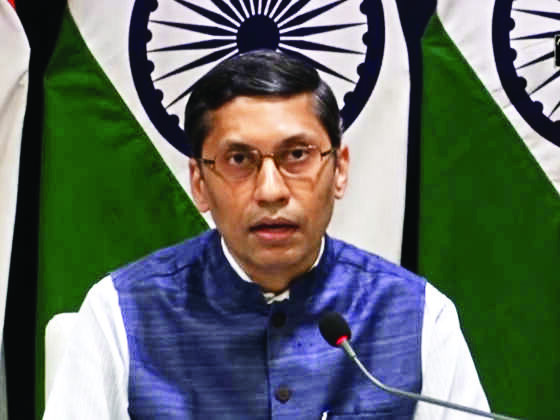'It's Chinese occupation for 60 years'

New Delhi: India on Thursday said the bridge being built by China across Pangong lake in eastern Ladakh is in an area that has been under illegal occupation of that country for around 60 years and it has never accepted such action.
At a media briefing, External Affairs Ministry Spokesperson Arindam Bagchi also slammed China for renaming some places in Arunachal Pradesh and said instead of engaging in such antics, Beijing should work constructively with India to resolve the outstanding friction points in eastern Ladakh.
He described it as a "ridiculous exercise" to support "untenable territorial" claims.
On the bridge being built in the Pangong lake area, Bagchi said the government has been monitoring this activity closely.
"As regards reports about a bridge being made by the Chinese side on Pangong lake, the government has been monitoring this activity closely," he said.
"This bridge is being constructed in areas that have been under illegal occupation by China for around 60 years now. As you are well aware India has never accepted such illegal occupation," he said.
Bagchi said India has been taking all necessary steps to ensure that its security interests are fully protected.
"As part of these efforts, the government has also, in the last seven years, increased significantly the budget for the development of border infrastructure and completed more roads and bridges than ever before," he said.
"These have provided much-needed connectivity to the local population as well as logistical support to armed forces. The government remains committed to this objective," he added.
Meanwhile, India and China are yet to finalise a date for the next round of the Corps Commander-level talks on the eastern Ladakh border row with the Chinese military yet to positively respond to the Indian proposals for the dialogue, people familiar with the development said on Thursday.
The Indian side sent at least two proposals to the Chinese People's Liberation Army for the 14th round of the military talks, but the latter is yet to respond to the communications, they said.
The Indian proposals include a possible broad framework and agenda items for the talks, the people said.
The 13th round of the Corps Commander-level military talks in October ended in a stalemate with the Indian Army saying its "constructive suggestions" were not agreeable to the Chinese side.
In their virtual diplomatic talks on November 18, India and China agreed to hold the 14th round of military talks at an early date to achieve the objective of complete disengagement at the remaining friction points in eastern Ladakh.
However, there has been no response from the Chinese side on the holding of the 14th round of the Corps Commander-level talks, though it was agreed in the diplomatic dialogue in November to have it at an early date, the people cited above said.
The Chinese side has been adopting delaying tactics in resolving the standoff, said one of the people, adding that India has been firmly pushing for a complete disengagement at all the friction points in eastern Ladakh.
The eastern Ladakh border standoff between the Indian and Chinese militaries erupted on May 5, 2020, following a violent clash in the Pangong lake areas.
Both sides gradually enhanced their deployment by rushing in tens of thousands of soldiers as well as heavy weaponry.
As a result of a series of military and diplomatic talks, the two sides completed the disengagement process last year on the north and south banks of the Pangong lake and in the Gogra area.



